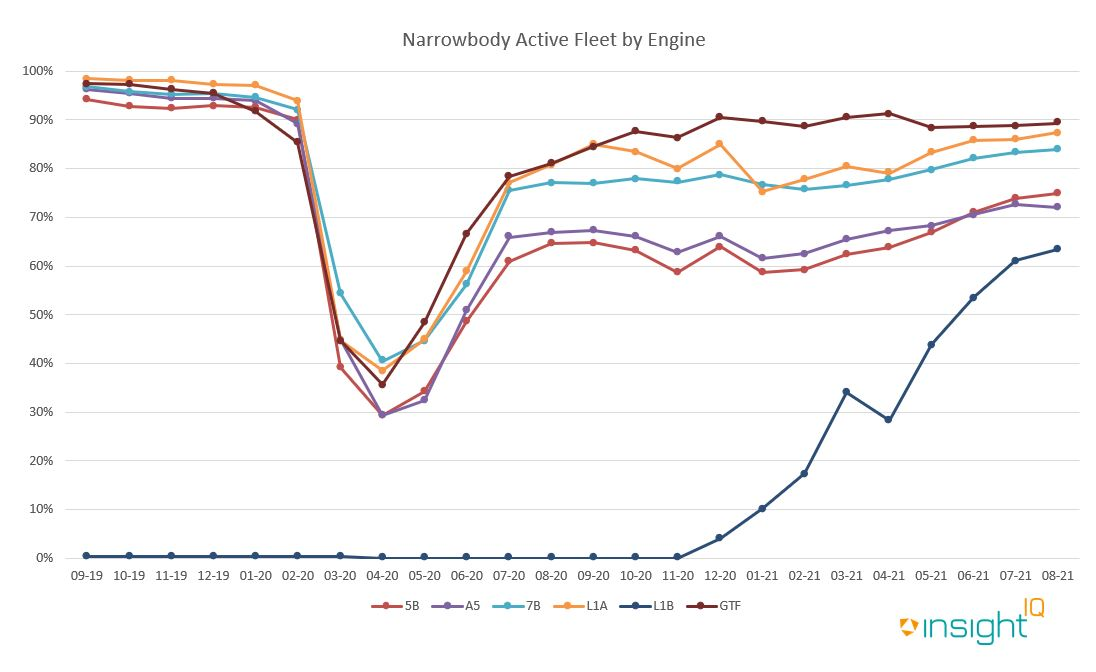21/10/2021
IBA has reviewed and updated our forecasts for narrowbody aircraft trends in October 2021.
Narrowbody engine performance has been predictably more stable than that of the widebody space, with the fleet benefiting from far higher volumes. Despite this, variations do apply through the generations. The CFM56-3 has performed best with the NG and CEO engines' -7B, -5B and V2500-A5 following. The CFM LEAP-1A, -1B and PW1100G (powering the Airbus NEO and Boeing MAX) are trailing behind.
We also recently published an update on widebody aircraft engine value trends.

Pratt & Whitney's GTF (Geared Turbofan) and CFM's Leap 1A and 7B engines continue to hold up well in the market. The GTF powered fleet is approaching 90% utilisation. This is primarily driven by the powerplant being utilised on the A220 and A320neo families, which have returned to service first. The CFM 7B's situation has been bolstered by the absence of the Boeing 737 MAX, which is still pending ratification in some regions. The A320neo and the 737NG are the best performing aircraft overall, followed closely by the Airbus CEOs. CEO configured Airbus aircraft are still subject to high storage levels, but slowly returning to service. The two manufacturers have different outlooks on the current situation, with a confident attitude from Airbus being countered by a more guarded and cautious approach from Boeing. As such, predicting where any possible production increases might occur is challenging.
The mature narrowbody engine market is currently subject to huge oversupply, with a significant volume of stored engines. As such, IBA expects values will stay soft for some time. Market values are within 5% - 10% of base. Whilst we are not witnessing vast trading capacity, IBA expects market values to rise back up to meet the base value curve.
Historically, utilisation of the Boeing 737NG's CFM56-7B engine has fallen short of the Airbus A320ceo's -5B and V2500-A5 engines. Despite this, 737 demand and lease rates have benefited from the resurgence of the US and Chinese domestic markets as the world emerges from the pandemic. As such, the -5B's reliance on the European market makes it the weakest performer, with lease rates around the $40K - $50K mark. The -7B's values are better at $50K - $60K, and the V25's Airworthiness Directive has been a major driver of its $60K - $70K lease rate. IBA's long-term view is positive.
Newer narrowbody engine values are being influenced by strong order books (with around 3,500 engines on order) and extremely competitive bidding. This paints a clear picture of how attractive and sought after these assets are. The combination of the Airbus A320 fleet's dominance over the MAX and the Leap-1B's grounding for a significant period has put a dent in overall utilisation, but we have seen a positive uptick subsequently.
The A320neo's engines, the LEAP-1A and PW1100G, have recovered above their previous peaks. The latter's teething issues, now largely historical, have given the LEAP-1A an advantage over it but we may see rebalancing with the order volumes in place and we anticipate market values will move back up to base. Lease rate factors around 0.4% - 0.45% are common for all engines which underlines their attraction but may be unsustainable.
IBA's InsightIQ analysis platform flexibly illustrates multiple asset, fleet and market positions, actual and potential, to inform client choices and identify acquisition opportunities. Immediate access to crucial aircraft, engine, lease rate and fleet data eases appreciation of historic and future aircraft concentrations and operator profiles.